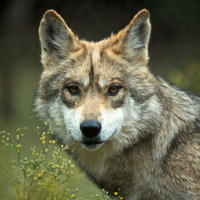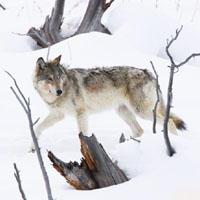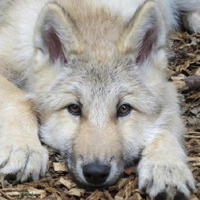After ayahuasca taught him to connect with divine energy, guitarist John Sheldon found a new heartfelt focus for his life’s work, writing songs that tell a new story about wolves in North America—and how we can save them from extinction.
John Sheldon (johnsheldon.com) was the lead guitarist in Van Morrison’s band at age 17 and wrote songs for James Taylor. Huffington Post says he has “an uncanny gift for conjuring the wild spirit,” and National Public Radio called him “one of the great guitarists of our time.” Sheldon has fronted his own bands and written hundreds of songs for film and theater as well as an autobiographical musical monologue, “The Red Guitar,” inspired by life-altering ayahuasca experiences in the Amazon. “Wolf 06,” his memorial to the famous Yellowstone alpha female who was shot and killed in 2012, went viral. Sheldon is currently working on a collection of new music for wolf conservation and will debut “Southwest Survivors"—an instrumental dedicated to the Mexican gray wolf, or lobo, for #Loboweek (March 23 – 28), an awareness campaign led by the Wolf Conservation Center (nywolf.org)—at Evolver’s Ayahuasca Monologues in New York City on March 21.
About two years ago, Sheldon caught the Wolf 06 story on NPR while driving home from tennis. He went into his recording studio as soon as he got home and began composing a memorial song for the grieving conservationist community. His new instrumental piece honors the lobos, the most distinct gray wolf sub-species and the smallest and southernmost of North American wolves. Lobos were almost rendered extinct by human hunters, and reintroduction efforts have established a small population of 109 descendants of the last remaining Mexican gray wolves who were captive bred and released into their native territories. But even with an endangered classification, lobos remain vulnerable to a hostile, antiquated political and economic environment.
I caught up with Sheldon, my friend and neighbor, in Amherst, Massachusetts, just as he was preparing to release “Southwest Survivors.”
You’ve gifted two moving instrumentals, “Wolf 06” and “Running Free,” to the wolf advocacy community, and now you have “Southwest Survivors.” Are you thinking about creating an entire collection for the wolves?
Yes, I’m thinking about doing more. I have one in process for Wolf OR7 and the Rogue Pack, and I have an idea for another piece. But I need to visit some wolves if I’m going to keep going with it because just reading about wolves and listening to recordings isn’t enough.
We need to plan a visit at the Wolf Conservation Center in Salem, New York. It’s so close! Around dusk, if you howl in the direction of the wolves’ enclosures, they all howl back and you can hear the different types of wolves and the different packs. They harmonize with each other. You just can’t believe it.
Yes, I’d like to hear that sound in person. Sound is my way into the spirit world. Sound carries so much information. You can’t decode it. And wolves howling—that’s a very powerful sound. Our wolves around here were all killed years ago, but we still have coyotes who live in the conservation area in our backyard, and sometimes they start going, that sound—it’s a primeval sound. It might be some part of our collective memory. It might be genetic memory. I don’t know a lot about wolf or coyote biology or behavior, but I just love the sound they make and the vibe I get from that sound. It’s very personal. It’s a connection I feel through what I hear.
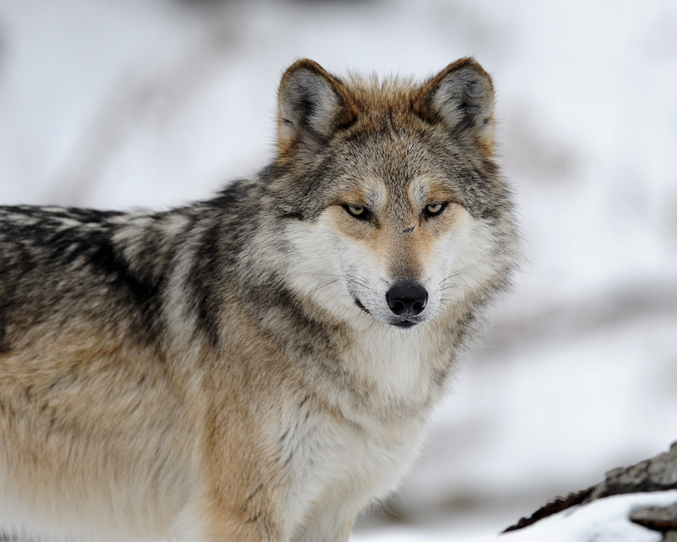
Mexican gray wolf (Canis lupus) “Lobo” • “Sound is my way into the spirit world. Sound carries so much information. You can’t decode it. And wolves howling—that’s a very powerful sound.” – John Sheldon
SOUTHWEST SURVIVORS
Tell me about the soundscape you’ve created in “Southwest Survivors,” your new song for the Mexican gay wolf, or lobo.
I didn’t want to anthropomorphize the lobo. I’d rather he remain a mystery. Nature is mysterious.
Music is something that I know, but it is a human invention with organized structures and sounds and things like melodies and rhythm, an expression of humanity. So there are people playing music, but then there’s a wild wolf in there somewhere doing what wolves do. I wanted the wolf to be free inside the human construct, and every now and then you hear him. The wolf needed be in there in and around the melody of the Spanish guitar. So now we’re projecting that sound over the lobo’s native territory. Toward the end of the piece, the wolf takes over the melody, so it's like the wolf taking control of the song.
The music is very cinematic.
I used to watch cowboy movies, and back then Ennio Morricone was doing a lot of the soundtracks. He was very creative and inventive. He used a lot of instruments that people weren’t using, and he used the electric guitar really beautifully as well. And he wrote themes, melodic themes, like the lobo theme you hear in “Southwest Survivors.” The music in those movies is actually better than the movies.
And if you took away the soundtrack…
The movie wouldn’t be nearly as good. I always associate Morricone’s music with that wide-open landscape—this feeling of exhilarating distances you can see. And I feel a close connection to those places, and that’s also the native territory of the lobo, where thousands of them used to live. So all of these wolf pieces, so far, have built musically on that influence. You hear the music, but you see an image with it—you get the feeling of running free. You need a wide-open landscape to run free; you can’t run free in city blocks. You'd be arrested.
Tell me about the lobo in “Southwest Survivors.” That melodic lobo theme came from somewhere.
In the cowboy movies I watched when I was growing up, the style that came through was to glorify men with guns. The cultural conditioning was about what a male should be—domineering and violent. In most of the Westerns, the soundtrack enhanced the heroic, macho cowboys riding with guns and dominating the landscape and killing whatever was in their way. It was “how fast can you draw?” and “how accurate is your shot?” The pioneer spirit was about claiming ownership over the lands, subduing the new frontier. That’s no longer there.
So we have a new new frontier!
The new frontier is about expanding consciousness. So in my song, instead of the cowboy as the hero, it is a heroic lobo in a land where humans also live. It’s important that the new story be written, and the new story is about finding a better balance. The violent, domineering man on the horse with a gun is old. That story is over. The lobo living free in its native wild landscape is a new hero in a new story. And the people who are working against all odds to save the lobos are new characters in that new story.
They’re also heroes.
If there’s any glory in “Southwest Survivors,” it’s for a new narrative, which is about the Mexican gray wolf surviving the humans who are stuck in a previous era of thinking and the humans who have evolved and who are awake and trying to help save it. I wanted to be free of the old story, and I wanted to reverse the hero. In the new story, the lobo is the hero and the story is about the spirit of survival and freedom. In today’s world it is heroic for any wolf to survive. But those wolves aren’t surviving on their own.
So in the new story, there’s one group of humans who almost wiped them out and continues to kill them, and they’re the antagonistic force. There’s another group of humans who are working against all odds to save them. But the lobo is the central hero.
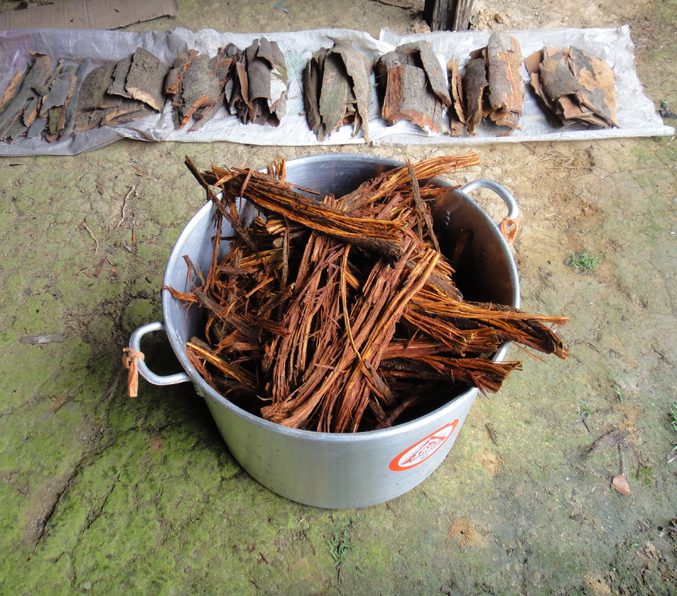
Ayahuasca • “Ayahuasca changed the direction of my life and the role or the craft of my art. When you experience the energy world or the spirit world directly, you realize that—that’s the world to connect with. That’s the world that can make change and transform.” – John Sheldon
THE AYAHUASCA EXPERIENCE
You have decided to devote the rest of your musical life to serving and protecting the earth. What inspired this change of focus—and did it have anything to do with ayahuasca?
I think it had everything to do with ayahuasca. Ayahuasca changed the direction of my life and the role or the craft of my art. Ayahuasca was the most powerful spiritual experience I’ve ever had. When you experience the energy world or the spirit world directly, you realize that—that’s the world to connect with. That’s the world that can make change and transform. The goal is to use your work to bring that energy into our world in whatever way you can.
I don’t have control over how other people relate to it or what people choose to do with it, but I feel like it is possible to remind people—because I think we tend to forget—that we’re all connected and that we’re all part of nature. I’m always grateful whenever somebody’s work reminds me again what my true nature is. Instead of some random collection of molecules walking around in a body that evolved out of the ooze and that’s just going to break down and become ooze again, now there’s another perception of being a part of this divine energy. You see this spark of divine energy in the ayahuasca and you see that you are made of this divine energy. You just want to remind people, if possible, and you want to remind yourself too.
You’ve been given the gift of music. Would it be any different if you were, say, a painter?
I don’t think so. It’s an intention. You set an intention for your work, and that gives you a direction to go in. The intention is to connect with this energy that you can call “spirit energy,” and people have different names for it. Some people might call it “God.”
I would like to connect with the energy produced by the sum of all things, the energy that’s informing all things and all life. If I were a mystic or if I were in a different tradition, maybe I meditated 12 hours a day, I might be connected right up. But I come from something else. I need to use the art to move toward that.
But you picked up a red guitar one day, and…
Well that was the path that opened up to me for this.
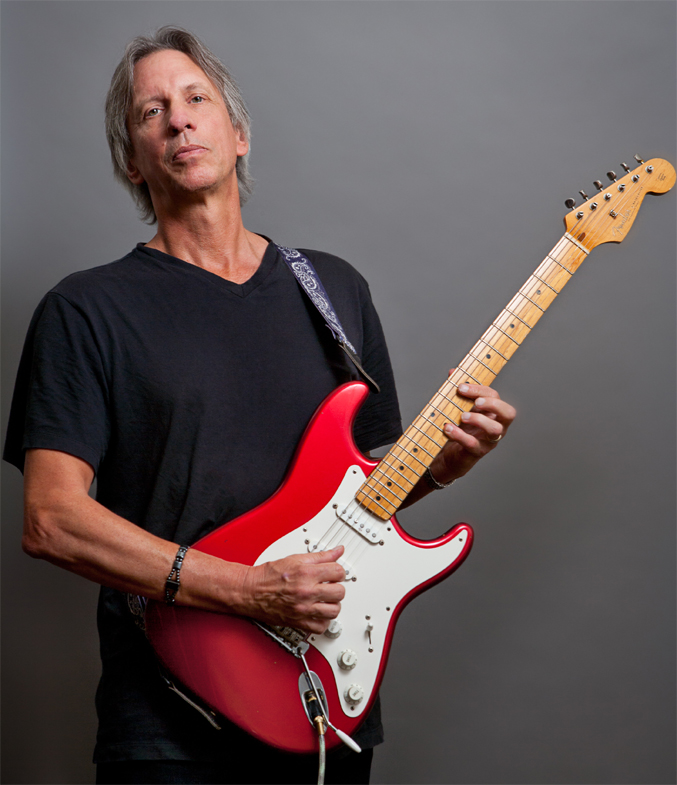
The Red Guitar • “The Spirit of the Stratocaster is about freedom, versatility, and responsiveness to the other side. I don’t think any guitarist would argue with those qualities.” – John Sheldon
SPIRIT OF THE STRATOCASTER
Did ayahuasca help you, as an artist, connect with spirit differently? I mean, you clearly were able to connect with spirit as an artist before ayahuasca.
Ayahuasca made me realize I’d been connected to spirit many times, but it was something that would just happen sometimes. I didn’t have any way to make it happen.
I used to think that I needed to be stuck by creative lightning—and that it would just happen and I had no control over when it would happen. And I would wait for that to come. I’d practice and wait. Now I don’t wait for it to happen. Now I don’t need some “lightning strike” of inspiration. All I have to do is work toward this intention of connecting. I set my sails and go toward it. I sail right at it!
So, it’s easier now set an intention to connect with the spirit?
Yes, it is easier for me. I think before the ayahuasca, I probably would have been afraid to set that as an intention because I would be afraid that I would fail. Or I would be afraid that maybe I was being a little crazy. The internal dialogue would be, “The world is not like that. The world is a matter of cause and effect. You’re taking a leap of faith.” Now it’s more like, “I know this energy is there, and I’m going to connect with it.” And it’s perfectly possible that someone can say, “Well, how do you know that it’s there?” And I don’t want to get into that discussion. You can’t define objective reality.
Let’s say there’s a 50/50 chance that that energy is there or it’s not? I’d rather go with, it is there. It just seems like a better way to go than it’s not there.
How does this connect to wolves?
I just started on this path. I’m newly arrived at this. I’ve done three wolf songs now. Maybe four and one in process.
And you’ve written other environmental songs. “Earth Blues” is an eco-rabble-rouser.
That’s also post-ayahuasca, so it’s also fairly new. That was me saying, I’m going to find my way in. I’m going to inquire, I’m going to ask what it feels like to be the Earth when it is scraped and mined and clear-cut by unconscious, oblivious beings who have no idea that it’s a conscious being. And I put those in the music. They’re feelings. So I’m reaching out into some empty space toward the Earth spirit and saying, “Come and sing and play through me.” That’s the intention.
Like channeling?
Exactly. And to remind me, because in the end, environmentalism for me comes down to self-inquiry. What is my relationship, my bond with this Earth, this home of mine? Because I was never taught to have a relationship with it.
I did have a relationship with the Earth when I was a little boy. I got to play in it quite a bit in some really nice natural environments, which is more than a lot of kids have. And looking back, I see that I was really connected into this environment and it was informing me. It was moving my arms and legs, teaching me how to live in it.
What happened?
I was educated out of it, into some abstract world of the mind. I was told, like everyone else I knew, that “you need to live in your mind now.” They actually believed that, so they tried to teach us how to get out of that beautiful world of the heart connection with the Earth and to get into our minds because “that’s what civilization is.”
I’m astounded by people who don’t know that that’s what happened to us all, and that’s why we have this situation where our environment is under siege. It’s because we’re in our minds now. If we were in our hearts—or at least if our minds and hearts were connected—this wouldn’t be the case. Instead we would be astounded by what’s around us in nature, and the closer you look the more astounding it is. We would be loving and celebrating every moment of being part of it!
Your Amazon “Cricket Scribe” song is also about an animal spirit—or an insect spirit, in the case.
The crickets were doing just what the crickets do, but the sound of the cricket and that particular cricket sounded like a sentient intelligence. The sound was so precise, and the cricket repeated that sound exactly the same way over and over again, as if it were occupying a sonic layer and no place else. On a summer night, when you’re hearing crickets, it seems clear that they have a web of communication between them and between other beings, just like the wolves do when they all howl together in the hills. It’s not even confined to crickets communicating with crickets. Maybe they’re communicating with other beings, like other kinds of crickets or insects or frogs or snakes or birds. And if you wanted to tap into that communication matrix, you could.
So, it was another experience of going in through sound.
When I’m in the medicine, I can focus my hearing like a laser. I can focus through all the other sounds and find one sound and stay on it incredibly, which is another way ayahuasca changed my music. Sonically, everything is occupying a space and a field—and where does it go out of the field or where does it morph? I can hear it all much, much better than I used to.
For the guitar geeks like me, how do you make that wolf how with your guitar? I’m crazy about that sound.
I can only make that sound on the red guitar. I have a Stratocaster guitar that has pick-ups that I bought in Australia from a guy who makes pick-ups. No other guitar I have will make that sound, and it’s just setting the knobs in a certain way.
Do you use a wah?
No, I don’t use a wah pedal, but that’s what most people would do because it would make a howling sound.
Do you use the whammy bar?
Yes, I use the tremolo bar. That’s what everyone calls it now. Nobody really calls it a whammy bar anymore. It’s a “trem” now—that’s what the guitar geeks like me call the little handle that bends the note.
I also found that changing the pressure of my fingers will change the frequencies. You want the note to be slightly different each time so you don’t get bored with it. It’s not just one note. It’s usually a couple of notes with a wiggle in there or something. I really don’t know if other people could do it but it would be fun to see if they could. I don’t know how hard it is to do—I just know that one guitar will do it. When you play guitar, you try everything. I want to know all the sounds a guitar will make, like a painter’s palette, so I’m always fiddling with my guitars to find sounds I like.
Are there other musicians who you think might benefit from ayahuasca?
All of them!
Who would you invite to share ceremony if you could invite any guitarist?
The young ones. There are all these amazing young guys out there who are playing incredibly. I’d like to share ceremony with them. The ones playing on the streets somewhere. Some of these younger guys who are inventing alternative techniques.
Has ayahuasca changed your relationship with cannabis?
Yes, it has. Ayahuasca was done as a ceremony, and it was very clear that it needed to be a ceremony done with reverence and respect and humility, approached in the right way. When I came back from ayahuasca and tried marijuana again (mostly in the edible form), I instantly felt like I was in ceremony. I was in a sacred space. I don’t do it very often, but sometimes I’ll drink some cannabis tea and then play music, and I get into a beautiful space that is very creative.
And that wasn’t the case before?
I used to get paranoid and anxious, before but now the feeling of connection and of sacredness and connecting with energy is much bigger than the paranoia or anxiety. It’s as if ayahuasca straightened up a lot of energy so I don’t go down those thought paths anymore. The other path—the happy, connected to life path—is stronger.
How has ayahuasca affected your music monologues?
What came to me in the ayahuasca was a voice talking me, a narrator. I asked the voice, “Why are you talking to me? Do you want me to share this or keep it to myself?” The answer that I got was, “Share it.” Like a storyteller.
Like a modern bard or a troubadour?
Yes. The monologue was a way to put the storytelling right into the music.
So, why “The Red Guitar?” I mean, it could have been anything.
It was the spirit of the Red Guitar—to tell the story of the journey of being an artist of being a musician. To talk about it, to tell about it.
And it’s a timeline of sorts.
“The Red Guitar” is one person’s journey through human institutions, which are oppressive. School was one of the first institutions—the way most of us were taught to turn our backs on what was going on outside the window and focus on what was on our desks, mathematics and history.
I also went to church as a boy, and it hit me that the ritual didn’t have any energy. Nobody was excited or lively. If the people in the church had been excited and happy about church, it might have been different. I was in a psych ward for a while as a teen, so that’s part of my story, but what’s interesting in the story is that the psych ward just turned out to be another institution. The institutions are one thing, but people can transcend the institutions somewhat.
So you caught onto this institution pattern early on, and you had the soul of an artist. And these institutions didn’t work for you, and you become depressed.
“The Red Guitar” is really about freedom, becoming free. In the early days, rock ‘n roll represented freedom from these oppressive institutions where we were being trained to be these upstanding citizens.
Breaking out of that 1950s model.
It was hard for us to focus on being model citizens because this music was like a siren song that was calling us toward freedom and joy. It crested in the ‘60s and then broke somewhere at the end of the ‘60s. And then rock ‘n roll also became an institution.
Did you go to the Amazon primarily to get off the psych meds that you’d tried to get off for 15 years?
That was a primary motivation, but it was also that I wanted the direct experience of the divine, the spiritual.
What I’m really hearing is that you came back from ayahuasca with an open invitation into the spirit world and also with a new methodology, this mantra of how to shift or flip a bad situation or a negative viewpoint around if it isn’t working for you.
The ayahuasca really shows you your own shit, meaning what you’re bringing to the situation and how you’re manifesting things in those situations. It shows you that so perfectly and in Technicolor. And it’s like, “Well then, if you want to change this then you have to take responsibility for this.”
And it’s kind.
It’s showing you your own stuff, but there’s no punishment. There’s only, this is what you do when you get scared, this is what you do when you get uncertain, this is how you project things on to certain people or situations, this is what you do—and this is how to change this.
And it presents you with real world ways.
Yes, they’re real ways, but it’s difficult to talk about them in the real world because you start talking about them as spirits and then people’s eyes sort of glaze over.
Let’s say you were really jealous of somebody you think has a better life than you do. The ayahuasca will show you your own version of jealousy, which has its own characteristics. They’re very specific to you, and you know what it looks like, what it sounds like and what it says to you as it sits on your shoulder: “Look at him. He has more than you’ll ever have. He didn’t make the wrong decisions.” After the ayahuasca, instead of saying, “I don’t want to be jealous anymore,” you might say, “I don’t want to connect to that spirit. I don’t wish to engage with and give energy to that spirit.” You learn how to disengage with that spirit. You figure it out. And then you learn how to do that with all the negative spirits.
How would you describe the Spirit of the Stratocaster?
The Stratocaster has affected the world more than you would think—and it’s connected with freedom. Buddy Holly was the first person to use a Stratocaster in a rock sound, and when you listen to recording of him playing, it sounds like freedom.
So the Stratocaster is an instrument through which you could translate your experiences in the spirit world?
Intuition is one of the senses that people talk about, but we don’t really know what it is. It’s a word that is trying to describe a sixth sense. The Stratocaster is responsive to something that somehow you’re picking up some way other than through the five senses. And intuition is huge in what I do.
So I’d say the Spirit of the Stratocaster is about freedom, versatility, and responsiveness to the other side. I don’t think any guitarist would argue with those qualities.
Everything has a spirit.
***END***
Zoe Helene (zoehelene.com) is an artist, activist, and Cosmic Sister who has a passion for promoting and connecting kindred-spirit trailblazers in mutually supportive ways. She works tirelessly to help communicate messages of love, liberty, and informed pro-activism. Zoe is a dedicated wolf advocate and woman of the Psychedelic Renaissance.
Visit John Sheldon (www.johnsheldon.com) to download “Southwest Survivors”
Visit Wolf Conservation Center (www.nywolf.org) for information about #Loboweek
Photo of Mexican gray wolf (Canis lupus) "Lobo" by Cynthia Kidwell
Photo of John Sheldon by Photo by Jeff Skeirik (www.rawtographer.com)
Photo of Ayahuasca by Zoe Helene (www.zoehelene.com)
Hashtags + Handles: #loboweek, #ayahuasca, #stratocaster, #cannabis, @cosmicsister, @nywolforg
